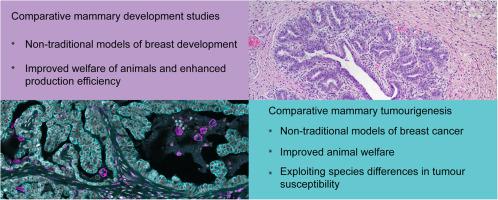Seminars in Cell & Developmental Biology ( IF 7.3 ) Pub Date : 2020-10-17 , DOI: 10.1016/j.semcdb.2020.09.010 Katherine Hughes 1

|
Sheep, cows, cats, and rabbits are kept by humans for agricultural purposes and as companion animals. Much of the mammary research in these species has focussed on mastitis in the case of ruminants and rabbits, and mammary tumourigenesis in cats and rabbits. However, similarities with the human breast suggest that these species may be currently underutilised as valuable comparative models of breast development and disease. The mammary gland undergoes cyclical postnatal development that will be considered here in the context of these non-traditional model species, with a focus on the mammary microenvironment at different postnatal developmental stages. The second part of this review will consider mammary tumour development. Ruminants are thought to be relatively ‘resistant’ to mammary tumourigenesis, likely due to multiple factors including functional properties of ruminant mammary stem/progenitor cells, diet, and/or the fact that production animals undergo a first parity soon after puberty. By contrast, unneutered female cats and rabbits have a propensity to develop mammary neoplasms, and subsets of these may constitute valuable comparative models of breast cancer.
中文翻译:

羊、牛、猫和兔的比较乳腺出生后发育和肿瘤发生:探索动物园
羊、牛、猫和兔子被人类饲养用于农业目的和作为伴侣动物。这些物种的大部分乳腺研究都集中在反刍动物和兔子的乳腺炎,以及猫和兔子的乳腺肿瘤发生上。然而,与人类乳房的相似性表明,这些物种目前可能未被充分用作乳房发育和疾病的有价值的比较模型。乳腺经历周期性的出生后发育,这里将在这些非传统模式物种的背景下考虑,重点关注不同出生后发育阶段的乳腺微环境。本综述的第二部分将考虑乳腺肿瘤的发展。反刍动物被认为对乳腺肿瘤的发生具有相对“抵抗力”,可能是由于多种因素,包括反刍动物乳腺干/祖细胞的功能特性、饮食和/或生产动物在青春期后不久进行第一次分娩的事实。相比之下,未绝育的雌性猫和兔子有患乳腺肿瘤的倾向,其中的子集可能构成有价值的乳腺癌比较模型。



























 京公网安备 11010802027423号
京公网安备 11010802027423号